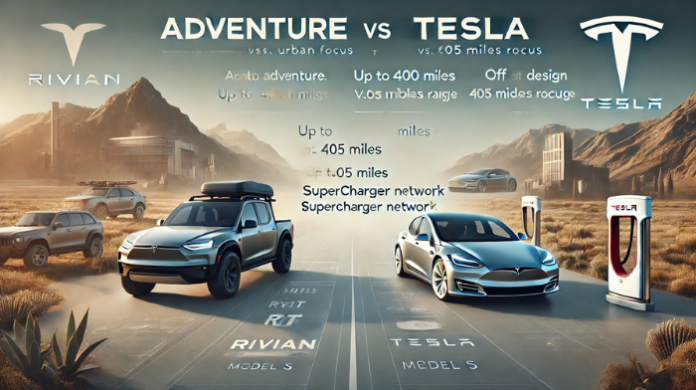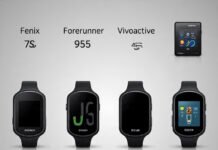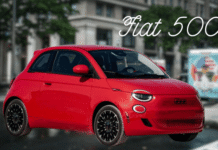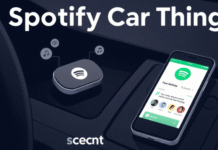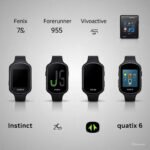Last Updated on December 14, 2024 by Rida Gul
Table of Contents
Introduction
As the electric vehicle (EV) market continues to expand, two companies that have emerged as significant players are Rivian vs. Tesla. While Tesla has established itself as a pioneer in the electric vehicle industry, Rivian is a newer entrant that aims to carve out its niche by focusing on adventure-oriented electric trucks and SUVs.
This article provides a comprehensive comparison of Rivian and Tesla, examining their features, performance, and key differences to help potential buyers make informed decisions.
Comparison of Rivian vs. Tesla
| Aspect | Rivian | Tesla |
| Focus | Adventure and off-road capability | Long-range, high-performance EVs |
| Vehicle Lineup | R1T (Truck), R1S (SUV) | Model S, Model 3, Model X, Model Y |
| Range | Up to 400 miles | Up to 405 miles |
| Charging Network | Adventure Network (limited coverage, off-road destinations) | Extensive global Supercharger network |
| Performance | 0-60 mph in ~3 seconds (R1T, R1S) | 0-60 mph in 1.99 seconds (Model S Plaid) |
| Interior Design | Rugged luxury with durable, sustainable materials | Minimalist design with central touchscreen controls |
| Price Range | Starting at $73,000 (R1T) | Starting at $40,000 (Model 3) |
| Unique Features | Gear tunnel, adventure packages, off-road navigation | Autopilot, Full Self-Driving, over-the-air updates |
| Towing Capacity | Up to 11,000 pounds (R1T) | Up to 5,000 pounds (Model X) |
| Target Audience | Outdoor enthusiasts, adventure seekers | Urban drivers, tech-savvy consumers |
This table summarizes the core differences and highlights between Rivian and Tesla, helping potential buyers choose based on their preferences.
Overview of Rivian and Tesla
Tesla
Founded in 2003, Tesla, Inc. has become synonymous with electric vehicles. Under the leadership of CEO Elon Musk, the company has revolutionized the automotive industry with its innovative technologies, extensive Supercharger network, and commitment to a sustainable future.
Tesla’s lineup includes the Model S, Model 3, Model X, and Model Y, all of which have garnered accolades for their performance, safety, and advanced features.

Rivian
Rivian, established in 2009, has positioned itself as a manufacturer of electric vehicles designed for outdoor enthusiasts. The company gained significant attention with the unveiling of its R1T pickup truck and R1S SUV, which are tailored for adventure and off-road capabilities.
Rivian aims to differentiate itself through its focus on rugged design and innovative technology, appealing to consumers who prioritize outdoor activities and adventure.
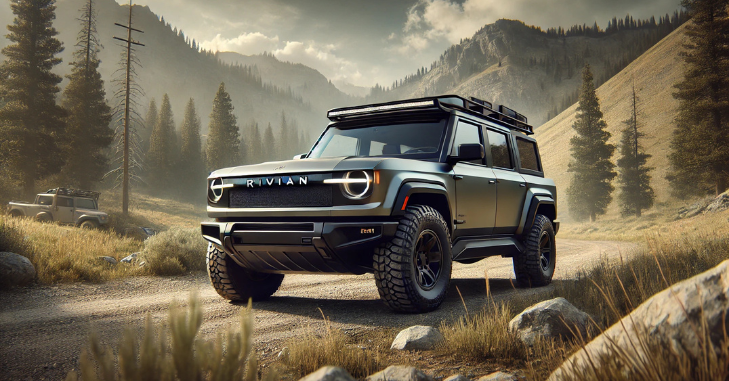
Rivian vs. Tesla (Key Features Comparison)
Design and Build
Tesla
Tesla vehicles are known for their sleek, modern designs, characterized by minimalist interiors and cutting-edge technology. The exterior design emphasizes aerodynamics, contributing to efficiency and performance.
Inside, Tesla vehicles feature a spacious cabin with a central touchscreen that controls most vehicle functions, providing a futuristic driving experience.
Rivian
Rivian’s design approach combines ruggedness with sophistication. The R1T and R1S feature robust exteriors designed to withstand the rigors of off-road driving. The interior is both functional and stylish, incorporating sustainable materials and thoughtful storage solutions.
Rivian vehicles also include features like a gear tunnel and a built-in camp kitchen in the R1T, appealing to outdoor enthusiasts.
Performance
Tesla
Tesla vehicles are renowned for their impressive performance metrics. The Model S Plaid, for instance, boasts 0-60 mph acceleration in under two seconds, making it one of the fastest production cars globally.
Tesla’s dual and tri-motor configurations offer exceptional handling and all-wheel drive, ensuring stability in various driving conditions. Additionally, Tesla’s long-range capabilities are a significant selling point, with some models exceeding 400 miles on a single charge.
Rivian
Rivian’s R1T and R1S also promise impressive performance, particularly in off-road scenarios. Both models feature quad-motor systems, offering independent torque control to each wheel, which enhances traction and stability on challenging terrains.
The R1T can accelerate from 0-60 mph in around three seconds, positioning it as a high-performance electric truck. Rivian vehicles are designed with an adjustable air suspension system, which allows for increased ground clearance and off-road capability.
Battery and Range
Tesla
Tesla has a well-established reputation for battery technology, with a focus on maximizing range and efficiency. The company’s vehicles come equipped with high-capacity battery packs that support long-distance travel. Tesla’s Supercharger network further enhances the convenience of long trips, allowing for rapid recharging.
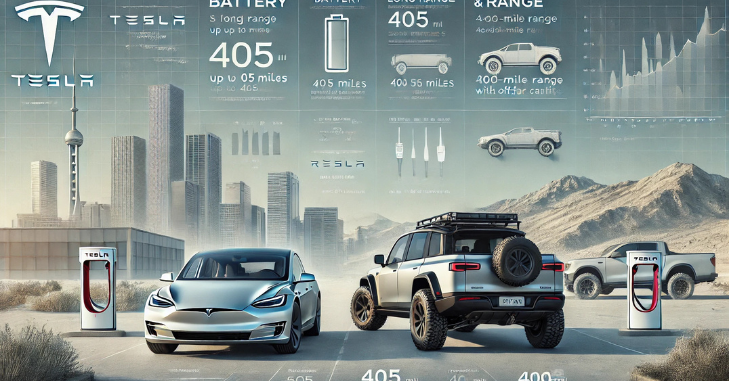
Rivian
Rivian offers multiple battery pack options, with the largest providing an estimated range of over 300 miles on a single charge. While this is competitive, it does not reach the upper limits of Tesla’s range of capabilities. Rivian is also developing its charging network, known as Rivian Adventure Network, which aims to provide fast charging at key outdoor locations, catering to its adventurous target market.
Technology and Features
Infotainment and Connectivity
Tesla
Tesla’s infotainment system is one of the most advanced in the industry, featuring a large central touchscreen that controls navigation, media, climate, and vehicle settings. Over-the-air software updates continually enhance the system, adding new features and improving functionality.
Additionally, Tesla vehicles come equipped with features like Autopilot and Full Self-Driving (FSD) capability, which leverage advanced sensors and AI to provide semi-autonomous driving experiences.
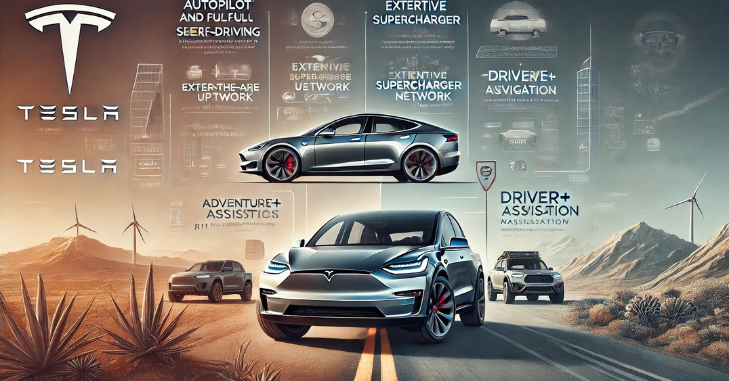
Rivian
Rivian’s infotainment system is also centered around a large touchscreen, but it offers a different user experience. The interface is designed for ease of use, with features tailored to outdoor activities, such as Route Planner, which considers terrain and charging stations relevant to adventure trips.
Rivian vehicles also include a suite of driver-assist features, although they are not as advanced as Tesla’s Full Self-Driving capabilities.
Safety Features
Tesla
Safety is a cornerstone of Tesla’s design philosophy. All Tesla vehicles come equipped with a robust suite of safety features, including collision avoidance systems, emergency braking, and lane-keeping assistance.
The vehicles consistently receive high safety ratings from organizations like the National Highway Traffic Safety Administration (NHTSA) and the Insurance Institute for Highway Safety (IIHS).
Rivian
Rivian places a strong emphasis on safety as well, incorporating features like automatic emergency braking, adaptive cruise control, and a comprehensive airbag system. The vehicles are also built with a sturdy frame designed to protect occupants during collisions. Rivian’s rigorous testing ensures that its vehicles meet high safety standards.
Market Position and Pricing
Tesla
Tesla’s pricing strategy varies across its lineup, with the Model 3 being the most affordable option, starting at around $40,000. The Model S and Model X, being luxury vehicles, are priced significantly higher, often exceeding $100,000 for fully equipped versions.
Tesla has established a strong brand presence and enjoys a loyal customer base, which contributes to its market dominance.
Rivian
Rivian’s R1T and R1S are positioned as premium electric vehicles, with starting prices around $67,500 for the R1T and slightly higher for the R1S. While this pricing is competitive for the features offered, it places Rivian in a different market segment compared to Tesla’s more affordable options. Rivian’s appeal lies in its focus on adventure and outdoor capabilities, attracting a niche audience of outdoor enthusiasts.
Key Differences
Focus and Target Audience
Tesla has built its reputation on being a mainstream electric vehicle manufacturer, focusing on a wide audience that includes both luxury buyers and budget-conscious consumers. Its vehicles cater to a variety of needs, from daily commuting to high-performance driving.
Rivian, on the other hand, targets a more specific audience—adventure seekers and outdoor enthusiasts. By emphasizing rugged design and off-road capabilities, Rivian aims to carve out a niche in the electric truck and SUV market.
Production and Delivery
Tesla has been mass-producing vehicles for several years, with established supply chains and production facilities. The company has faced challenges with production scalability, but it has largely succeeded in meeting demand.
Rivian, as a newer company, is still ramping up production. While it has received significant pre-orders, including a notable deal with Amazon for electric delivery vans, Rivian is still in the phase of scaling its manufacturing capabilities. This can lead to longer wait times for customers compared to Tesla’s more established delivery timelines.
Charging Infrastructure
Tesla’s Supercharger network is one of the most extensive in the world, providing fast charging options that cater to long-distance travel. This infrastructure has been a significant advantage for Tesla owners, making it easier to use their vehicles for road trips.
Rivian is developing its own Adventure Network, but it is still in the early stages compared to Tesla’s established network. Rivian’s focus on charging locations near outdoor destinations aligns with its brand ethos but may limit convenience for users in urban areas.
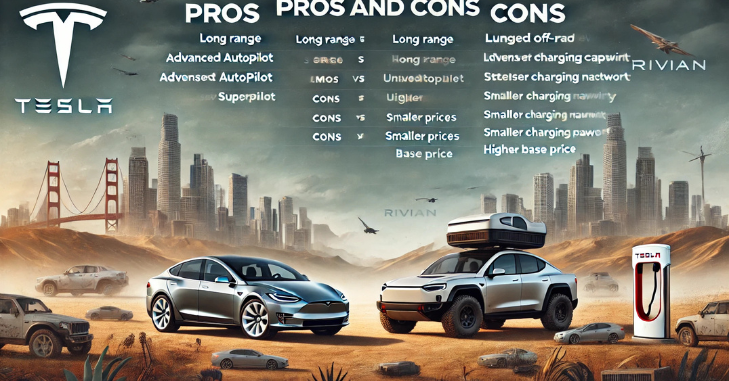
Pros and Cons
Tesla
Pros:
- Extensive Supercharger network.
- Longest range among EVs.
- Advanced self-driving technology.
Cons: - Minimal customization options.
- Premium models are expensive.
Rivian
Pros:
- Exceptional off-road capabilities.
- Rugged design tailored for adventurers.
- Unique features like the gear tunnel.
Cons: - Limited charging infrastructure.
- Higher starting prices compared to Tesla’s entry-level models.
Who Should Choose Tesla?
Tesla is ideal for buyers seeking:
- Long-range electric vehicles.
- Advanced self-driving features.
- Access to a vast charging network.
- Sleek, futuristic designs.
Who Should Choose Rivian?
Rivian is perfect for:
- Adventure enthusiasts need off-road capability.
- Buyers prioritize rugged durability.
- Those interested in outdoor-oriented features.
- Eco-conscious consumers supporting niche brands.
Conclusion
When comparing Rivian and Tesla, it becomes clear that each company offers unique strengths and appeals to different segments of the electric vehicle market. Tesla remains a dominant force with its established technology, extensive charging infrastructure, and broad appeal.
In contrast, Rivian is carving out a niche focused on adventure and off-road capabilities, appealing to a specific audience of outdoor enthusiasts. As electric vehicles become increasingly popular, the competition between these two companies will likely drive innovation and enhance the overall EV market.
Whether buyers choose Tesla or Rivian will depend on their individual needs, preferences, and lifestyle choices. As both companies continue to evolve, it will be exciting to see how they shape the future of electric mobility.
Apart from that if you want to know about “Discharge Your Interior Speedster: Research the Universe of Supercar Driving” then please visit our “Automobile” Category.
FAQs
Rivian includes features like the gear tunnel for extra storage, a portable kitchen option, and adventure packages tailored for outdoor enthusiasts.
Tesla provides advanced driver-assistance systems like Autopilot and Full Self-Driving (FSD), over-the-air updates, and a minimalist, futuristic interior design.
Tesla is better suited for long-distance travel due to its superior Supercharger network and longer range on average.














